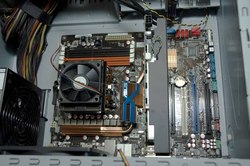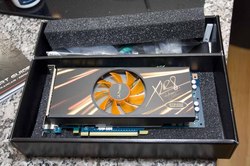Why would anyone want three PCs at home? I’m not talking about the machines shared with my family. These are my computers. Granted, two of them are discards; computers deemed too slow by others.
I have done most of what I could to optimize these older machines. They’re loaded with memory and unnecessary processes are shut down. You still can’t make a silk purse from a sow’s ear, but you can get a lot closer than most people expect.
The laptop, a Pentium II 300 MHz model, is my road machine. It’s got a wireless card and is often downstairs in the family room (especially if I’m watching TV and playing poker). It is sometimes sluggish, but never enough to be a bother.
 The second desktop is also a P-II 300. Well, it was until a few days ago.
The second desktop is also a P-II 300. Well, it was until a few days ago.
I wondered if it would be possible to bring this machine into the 21st century without spending much cash. TigerDirect was having a sale where the net cost (after rebates) of a motherboard, fast processor chip with fan, and memory was only $99.99. I decided to give it a try.
It took about three days for UPS to deliver my package. Looking in the box, everything was there, in its original packaging. So far, so good.
Fearing the 256MB RAM stick that came with the kit wasn’t enough, I went to Staples and bought another 256MB. It was $30, after rebate, bringing me to $130.
 What is missing in a deal like this is a great deal of documentation. There were no instructions with either the CPU chip (an AMD XP 2400) or the fan. There was a sticky label on the chip’s packaging saying, in essence, “you break it, too bad.”
What is missing in a deal like this is a great deal of documentation. There were no instructions with either the CPU chip (an AMD XP 2400) or the fan. There was a sticky label on the chip’s packaging saying, in essence, “you break it, too bad.”
Instructions don’t seem like a big deal, but mounting the fan isn’t totally intuitive and a thermal compound paste (included) has to be applied between the fan and chip.
My first step was unplugging the old motherboard, unscrewing and removing it from the case. No problem. It came out really easily.
 Since the computer industry standardized motherboard sizes, my new ATX board should fit exactly where the old board sat. It did. A new plate fit between the case and motherboard, allowing the external plugs for video, audio, mouse and keyboard to be accessible. So far, so good.
Since the computer industry standardized motherboard sizes, my new ATX board should fit exactly where the old board sat. It did. A new plate fit between the case and motherboard, allowing the external plugs for video, audio, mouse and keyboard to be accessible. So far, so good.
Each individual peripheral, like a disk drive, has to be wired for both data and power. It sounds tougher than it is. There are distinctly sized plugs for each operation. It’s tough to go wrong, though it is possible if you’re not looking, to put some plugs in backwards.
The manual for the Soyo motherboard was well illustrated and easily led me to the right sockets on the board for all these cables. I did have to call AMD to try and figure out how to set an on-board jumper. I was on and off the phone in two minutes.
AMD, if you’re listening, I’m impressed.
 It took a bit over an hour on the kitchen table before I was ready to plug it in. I lugged the case upstairs and plugged it into my KVM switch. KVM stands for keyboard, video, mouse. All it means is I can run two computers from one set of devices. Hitting the scroll lock key twice toggles my keyboard, mouse and monitor from one machine to the other. It’s pretty simple, saves space and lots of money.
It took a bit over an hour on the kitchen table before I was ready to plug it in. I lugged the case upstairs and plugged it into my KVM switch. KVM stands for keyboard, video, mouse. All it means is I can run two computers from one set of devices. Hitting the scroll lock key twice toggles my keyboard, mouse and monitor from one machine to the other. It’s pretty simple, saves space and lots of money.
The system started to power up, but the normal beep as it’s getting ready to go was replaced by a continuous tone for a few seconds and then… silence. The machine shut itself down.
Uh oh. I took a look at everything under the hood. Something had to be wrong. I didn’t see anything out of place. So, I went to Soyo’s website and searched out my problem.
Someone had described a similar outcome for another motherboard. It hinged on the safety circuitry not sensing the cooling fan on the computer chip. Sure enough, my fan was plugged into the wrong socket.
Though the fan was spinning, keeping things cool, the motherboard’s circuitry though it was just an extra fan, not the one necessary to keep the chip operating. I moved the plug and bingo, it booted.
I spent the next few hours going through a bunch of different operating systems, trying to decide what I wanted. I loaded Windows XP and two different flavors of Linux.
Since I was aiming to keep the cost down, I went with Linux. Specifically, it’s “Mandrake Linux 10 Community,” a close-to-production release. It’s free! I actually downloaded the installation disks the night before and burned them onto Cd’s. Unless you play games or run some very specific applications, Linux is fine. There are browsers, email programs, graphic design software, etc. Most of it them are free.
I find it a little more difficult to get answers to Linux questions, because I know fewer people who run it than Windows. But, I am constantly ‘mitchering’ with my machine, and that brings up situations most users wouldn’t get into.
I went to bed a happy man. My machine was humming along. This ugly duckling was now the fastest machine in the house. Life was good. And then, I woke up.
Hitting the power button brought nothing. No noise, no lights, nothing.
I had built this system in an old case with an older, weaker power supply. I can’t be sure, but my best estimation is the power supply was stressed with this new configuration. As it cooled, it broke down. A digital multimeter across the power pins showed no voltage anywhere.
My goal here was to keep costs down. Now, with the extra RAM, I was already $30 over my original cost. I could have spent $60 at CompUSA or Circuit City to get a new supply, but decided to log onto eBay and see what was available.
For $20, including shipping, I bought a 420 watt supply to replace the 230 watt model I’ve surely fried. It’s coming from California, so I’ll be without this machine for most of – maybe all – of the next week. My $100 machine is now $150.
Still, if the power supply is the problem, and if it boots up right away, this will be a great investment. For $150, a computer someone wanted to throw away, will be a screamer. And, I did it myself. It’s no big deal.
 As mentioned earlier my major birthday gift was a new computer. I wanted something beefy and speedy. That meant no store bought PC, but something assembled here at home–literally on the kitchen table!
As mentioned earlier my major birthday gift was a new computer. I wanted something beefy and speedy. That meant no store bought PC, but something assembled here at home–literally on the kitchen table! This is my first time with the new generation of powerful video cards. My card is quite imposing! It’s probably as powerful on its own as my last fully assembled PC.
This is my first time with the new generation of powerful video cards. My card is quite imposing! It’s probably as powerful on its own as my last fully assembled PC. The second desktop is also a P-II 300. Well, it was until a few days ago.
The second desktop is also a P-II 300. Well, it was until a few days ago. What is missing in a deal like this is a great deal of documentation. There were no instructions with either the CPU chip (an AMD XP 2400) or the fan. There was a sticky label on the chip’s packaging saying, in essence, “you break it, too bad.”
What is missing in a deal like this is a great deal of documentation. There were no instructions with either the CPU chip (an AMD XP 2400) or the fan. There was a sticky label on the chip’s packaging saying, in essence, “you break it, too bad.” Since the computer industry standardized motherboard sizes, my new ATX board should fit exactly where the old board sat. It did. A new plate fit between the case and motherboard, allowing the external plugs for video, audio, mouse and keyboard to be accessible. So far, so good.
Since the computer industry standardized motherboard sizes, my new ATX board should fit exactly where the old board sat. It did. A new plate fit between the case and motherboard, allowing the external plugs for video, audio, mouse and keyboard to be accessible. So far, so good. It took a bit over an hour on the kitchen table before I was ready to plug it in. I lugged the case upstairs and plugged it into my KVM switch. KVM stands for keyboard, video, mouse. All it means is I can run two computers from one set of devices. Hitting the scroll lock key twice toggles my keyboard, mouse and monitor from one machine to the other. It’s pretty simple, saves space and lots of money.
It took a bit over an hour on the kitchen table before I was ready to plug it in. I lugged the case upstairs and plugged it into my KVM switch. KVM stands for keyboard, video, mouse. All it means is I can run two computers from one set of devices. Hitting the scroll lock key twice toggles my keyboard, mouse and monitor from one machine to the other. It’s pretty simple, saves space and lots of money.